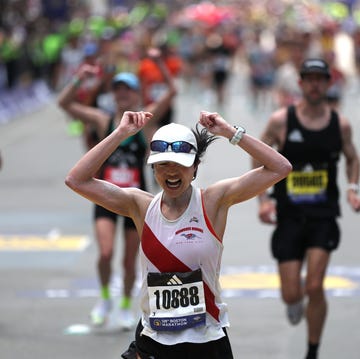Published: May 13, 2013 12:00 AM EDT Boston Marathon bombings, runners across the country felt as Mick Larrabee did. Larrabee, a 45-year-old physical therapist and father of three, watched events unfold from his home in Knoxville, Tennessee. During a news broadcast, he turned to wife and said, “I need to be there next year.”
She nodded, and Larrabee’s search for a qualifying race began. He eventually settled on the Charlevoix Marathon, a small race in Michigan that promises a flat course and a strong chance of cool weather even in late June. Larrabee sent his registration in, becoming part of the 14% increase in entries over the same period last year the race has seen since the April 15 attack.
Health - Injuries marathons Races in late August, early September see greatest surge All About 75 Hard before registration for the 2014 event opens in mid-September. (The Boston Athletic Association has yet to announce the official date.)
Tom Swinford, race director for the Newport Marathon in Oregon on June 1, doesn’t have numbers, but reports there has been a “definite spike” in entries over the last few weeks. Grandma’s Marathon, which takes place on June 22 in Duluth, Minnesota, had 25 more marathoners in 2012 than 2011; this year, the field has already increased by more than 100.
The most dramatic rise, however, belongs to events in late August and early September.
“Our marathon right now is double what it was at this point last year,” says Orhan Sarabi, race director for the Santa Rosa Marathon in California. “Thirty-four percent of our runners last year qualified, and our race date of August 25 is right before Boston registration opens, so it’s a double whammy.”
Long gone are the days when a runner could qualify in December, or even late October, and run the following April. (Last year, the Boston Marathon sold out by the first weekend in October.) These runners are maximize training time without risking being shut out of Boston.
The Tupelo Marathon in Mississippi, which had 246 finishers last year, reports that its registration shot up 30% after the bombings. Race director Mike Lail says every other email he receives is from a runner asking if the race is a Boston qualifier.
“We’ve never seen anything like it,” says Lisa Walkiewicz, vice president of communication for Via, a nonprofit in Allentown, Pennsylvania that puts on the Via Marathon in early September. The race—which boasts a downhill course that’s scenic and shady (and designed by Runner’s World Chief Running Officer, Bart Yasso)—typically draws about 900 runners total. It has 1,100 entries now, four months before race day. In 2012, 24.8% of the field qualified for Boston, the fourth highest percentage in the nation.
“We believe [the surge] is almost entirely related to people wanting to run Boston,” says Walkiewicz. “We’re on track to increase our numbers by 100% and are thinking we may need to cap entry.”
Of the six mid- to late-May marathons contacted for this story, none had experienced an increase in race entries, but most reported receiving more calls or emails than usual asking if they were a Boston qualifier.
A similar scenario is taking place for the Boston Marathon’s charity partners. About 2,000 runners raise approximately $11 million for local nonprofits each year. In an informal survey of seven of the race’s 35 official 2013 charities, all have received a greater number of inquiries than usual. Most characterize that increase as “huge.”
“Ninety percent of the people who contact us reference the bombings in the first sentence of their email or call,” says Kat Powers, director of communication for the American Red Cross of Eastern Massachusetts.
The Red Cross doesn’t track inquiries, but Team in Training, which raises funds for The Leukemia & Lymphoma Society, says it has 130 runners in its database with confirmed interest; typically a month after the race, that number is 20.
The New England chapter of the National Multiple Sclerosis Society estimates it has seen a 70% increase. And Dream Big!, a small nonprofit in Auburndale, Massachusetts that helps low-income and homeless girls, has received 45 requests so far, compared to a total of 45 inquiries last year.
Although charity runners don't need to secure a qualifying time, their wait can be just as nerve-wracking. Official registration for charity participants begins in September. Then they must bide their time until each organization announces who will receive its few, coveted spots.
Related:
2014 Boston Marathon Registration FAQ
He Ran Boston 8 Months After Tumor Surgery














